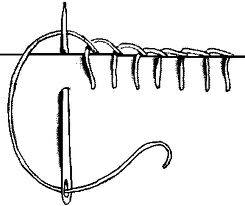Buttonhole or Blanket Stitch

A hand-stitching technique used regularly in the world of embroidery, needle-lace making and tailoring, in general, the buttonhole or blanket stitch is a technique that's crucial to understanding the world of embroidery. While forming the base for the stitching of needle-lace, the buttonhole or blanket stitch is also used to reinforce buttonholes. They are also quite effective when it comes to preventing a cut fabric from ravelling, while crewel embroidery utilizes them for making stems.
Buttonhole or blanket stitches are also popular when it comes to making sewn eyelets as well as when attaching an appliqué to the fabric. They are quite well known in the creation of couching stitches while, in the 19th century, buttonhole or blanket stitches were used to create edgy designs, , Top cash for cars canberra like the buttonhole stitch scallop, and were an integral part of cutwork like Broderie Anglaise.
The buttonhole or blanket Stitch
The process of creating a buttonhole or blanket stitch is simply about catching the loop of a thread on the surface of the fabric. However, the reason for the buttonhole stitch being different from the others is just that the needle doesn't pass back through the original hole, when going back towards the back of the fabric. Traditionally, the needle pierces the fabric, once again, on a right angle to the position of the original hole. As a result, the finished stitch would look like the letter "L", with the space between the stitches determining the actual difference.
In buttonhole stitches, the little "L" shaped stitches are packed tightly together while the blanket stitch has more generous spacing between its edges. This makes it perfect when it comes to preventing the ravelling of fabric and is also the reason why needle-lace work employs it often enough.
Here are some examples of buttonhole stitches that you are likely to encounter when dealing with this category.
• Blanket stitch
• Closed buttonhole stitch where the tops of the stitch are connected to form triangles.
• Crossed buttonhole stitch where the tops of the stitch cross each other
• Top-knotted buttonhole stitch
• German-knotted buttonhole stitch
• Tailor's buttonhole stitch
• Buttonhole Bars are a parallel row of thread that are laid across a bit of open space on the fabric or lace, before being completely covered with buttonhole stitches, all close to each other.
These versions or variations of the buttonhole or blanket stitch are all about helping you create beautiful have a look at, Digital Night Photography patterns through intricate technique.
Purpose
It is, without conflict, known as to where and why the buttonhole stitches got their name from - sewing buttonholes. These stitches were perfect when it came to keeping buttons in their place, try, DIY PEX Plumbing with a small half-knot at the top of each stitch making it less likely to unravel even if the thread were broken. By waxing and pressing the thread, before use, the strength can be increased, thereby making the entire buttonhole stitch a lot sturdier and preventing the thread from twisting as well.
The best part about the buttonhole stitch is that it is completely independent of the direction in which you want to stitch. All you need to do is hold the thread along the top edge of the material and just point the end in the direction you wish to sew in. Then comes the loop, with its top of the loop facing upwards, giving you a place also look at, Home Improvement Forum to push the needle through and then pass it through the fabric. Once it passes through the fabric, the next step is to pass it through the loop that's left on the front of the material.
Now, you need to tighten that stitch and keep the purl on the top, see-sawing the thread and using your nails look at, RC Car - General along the way. Then, when you arch the thread over the opening of the buttonhole on the front of the fabric and looping back down, you can create the remaining stitches. You start heading down in the opposite direction, through the loop on the top and then heading onto the back of the fabric, and repeating the steps as before to complete the perfect buttonhole stitch.
These buttonhole or blanket stitches were extremely popular in the 1800s but due to the lack of standards also see, Digital Photography Focus in cloth and clothing manufacturing, there wasn't any way of knowing what stitch was used and where, except by looking at it. Most clothes, in those times, were manufactured outside consider, Digital Night Photography of factories, on contracts, and that meant that every stitch depended largely on the people making them. Even the same place look at, RC Micro Tanks could have plenty of variations depending on who was working on what item.
As a result, buttonhole or blanket stitches have plenty of variations although this is the general direction that they tend to take. There are plenty of options for you to try and the most important thing is to learn the basics before you start heading into the variations. While the buttonhole or blanket stitch may sound complicated, you may find it surprisingly easier to execute when you actually get into the whole process.
 Nautical Antiques Nautical Antiques
Collecting nautical antiques is not just about getting naval artillery, but storing away a bit of na |
 Entertainment Memorabilia Entertainment Memorabilia
Entertainment memorabilia contains anything and everything that is related to a large entertainment |
 CB SSB Radio CB SSB Radio
CB SSB radio is one of the major technological innovations have been made in the field that have giv |
 Clay Doll Making Clay Doll Making
Clay doll making is a long standing traditional craft from many countries of The Orient. Clay doll m |
 Collectible Bottle Openers Collectible Bottle Openers
Collectible bottle openers come in all shapes, sizes and prices. Collectors are willing to shell out |